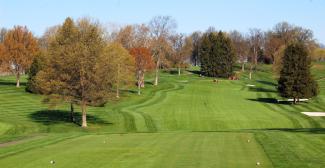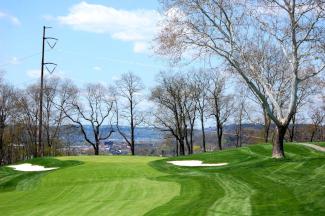Featured Golf News
Green Oaks Still Green after All These Years
Heading back to Pittsburgh this past April for a high school sports hall of fame induction, I have to admit I was just as excited about the golf outing planned as our 1978 state championship baseball team being honored for its accomplishments.

2nd Hole at Green Oaks
Country Club outside Pittsburgh
I grew up in Penn Hills, Pa., a "baseball guy" who tinkered in golf. Some 40 years later, I'm now a "golf guy" who barely watches baseball.
Golf as a 13-year-old was an end to a means for me. Caddying at Green Oaks Country Club in the village of Verona was a way to earn some cash and a unique opportunity to cash in on some free entertainment by teeing it up at the private club on Mondays.
I used to look forward to "caddie's day" on those Mondays, waking up at the crack of dawn, more often than not unable to see our tee shots land because of the intense fog that migrated up the mountain valley from the Alleghany River. I vividly recall following the ball's (a Maxfli blue or red dot, remember those?) water trail through the dew to find our shot … and then take another whack at it.

Donald Ross Made his way to
Pittsburgh in Early 1920s Because of
Booming Steel Industry
My clubs were rudimentary, to say the least, all costing $5 or less, plucked from a barrel of misfits at the nearby Sears & Roebuck Co. store.
Who knew? We were just kids out for some fun. And little did I know I was playing on a Donald Ross-designed golf course. Golf course architecture was the furthest thing from my mind at the time; sneaking my dad on the private course on those Mondays was far more prominent in my thought process.
I recall my father ribbing me about golf, saying it was a "stupid game" that he would never play. Less than a year later, I couldn't keep him off the course; golf becoming the only sport he ever really played. I hold those Monday memories with dad, of getting to play the "country club greens," dear to my heart now that he's gone.
Fast forward to this April and the banquet and golf outing with guys I haven't seen in 37 years. I casually logged on to the Green Oaks Country Club website before heading from North Carolina to Pittsburgh and was stunned to see that it was a Ross course. Living in the South for more than 30 years, I've fallen in love with some of the greatest works of Ross, from Pinehurst No. 2 to Pine Needles to Linville Golf Club, and all in between.

Opening Hole at Green Oaks CC,
Designed in 1921 by Donald Ross
Compared to some of the other private clubs in the Penn Hills area, Green Oaks always seemed kind of "simple" to me. And now, after studying Ross, I realize that yes, it is both simple - and complex. After blasting a 300-yard drive in the fairway for what appeared to be an easy approach shot as I revisited my golf stomping grounds in April, I then short-siding myself and three-putted for a 6 on the opening hole. I quietly nodded to myself and muttered that I just got "Donalded," a joke we all in the Tar Heel state appreciate, especially at Pinehurst No. 2.
As I made my navigated Green Oaks during this round of reflection I took in all the subtle design features that make Ross stand out from the rest of his contemporaries, those features I had largely ignored as a clueless teenager - the distinctive angles, the false fronts, the elevation changes.
And it seems no architect can make 6,300 yards seem like 7,000 as well as Ross. Each nine at Green Oaks marches toward a 750-foot cliff that overlooks the Alleghany River below, then returns down the "hill," which is a term Pittsburgh people use for mountain. In other words, Green Oaks is a perfect reflection of golf strategy, not brute force. Most of the downhill holes are shorter in nature, requiring a thought process, not repeated bench presses. The outward holes that climb with the terrain some 15-20 degrees are longer, making golfers use their entire bag. You remember a 3-iron, don't you?

Several Holes at Play along a
750-foot Cliff to Offer Panoramas of
Alleghany River Valley (All Photos by David Droschak)
Green Oaks opened in 1921, a year in which Ross designed almost 30 golf courses. Ross' work often followed the railroads, and you can see the valley tracks from the cliff, still humming with coal and other freight today. It's not too hard to imagine the Ross crew making their way up one of the valleys, with oxen and horses, and on to the Green Oaks property, which is a five-minute drive from famed Oakmont Country Club.
The Ross connection to Midwest cities such as Pittsburgh, Chicago and Detroit can be traced to Pinehurst, where Ross lived along the third hole at No. 2.
"Ross was all over the place in Western Pennsylvania and he did concentrate in the Pittsburgh area," said Michael J. Fay of the world-renowned Donald Ross Society. "By the early 1920s he did work in any city that was successful. And Pittsburgh was a hotbed at that point.
"All of these clubs back then were started by wealthy people," added Fay. "Most of his leads for building golf courses came from people who visited Pinehurst in the winter time. You had to have money to go to Pinehurst. And if you gave Ross an option of building up on a hill or down in a valley he would take up in the hill any time because he knew he would be able to drain the golf course."
Green Oaks is also a five-minute drive from the former Alcoma Golf Club, which opened in 1929, and Churchill Valley Country Club - each is no longer private venues. Alcoma has been renamed and is public, and Churchill Valley recently closed its doors.
However, Green Oaks trudges on, in large part because of the traditional layout designed by Ross. Once again, as kids we didn't realize just how drastic some of the peaks and valleys were at Alcoma, or being able to pinpoint that elusive flat lie at Churchill Valley that didn't seemingly exist.
"This golf course is THE draw for us," said head golf professional Ed Habjan, who once worked at Alcoma but has been at Green Oaks for a decade now. "The hills that we have here, you really don't play up and down them. You get on top of the hill and then you come down.
"Country clubs have changed all over," he added. "People don't use clubhouses like they used to. Our members are here to play golf. If we didn't have a clubhouse I'm not saying no one would miss it but it wouldn't be life-shattering to them."
Green Oaks has 260 golfing members, and 90 social members - a solid number in a rapidly aging Alleghany County.
After a 1982 U.S. Open Qualifier at Green Oaks, future Masters' champion and budding golf architect Ben Crenshaw stepped off the 18th green and said "playing here was like playing in heaven."
"As a kid you really didn't realize the difference, did you?" Habjan said of the Green Oaks' reputation a top-tier Ross course. "People see the advantages of this golf course over others now, for sure."
My eyes were certainly opened.
David Droschak has covered golf in the Carolinas for three decades, mostly with The Associated Press, where he worked for 20 years as AP sports editor in North Carolina prior to launching Droschak Communications, a full-service marketing and PR firm based in Apex, N.C.
Dave, 53, has covered numerous major golf tournaments, including the 1999 and 2005 U.S. Opens at Pinehurst Resort, and is a longtime member of the Golf Writers Association of America. Dave will represent Cybergolf to provide coverage of the historic back-to-back 2014 U.S. Men's and Women's Opens at Pinehurst No. 2 in North Carolina's Sandhills.
Dave was honored with the Sports Writer of the Year award in North Carolina in 2005, and is currently editor of Triangle Golf Today (www.trianglegolf.com), a print and online publication regarded as the "No. 1 Source for Golf News in North Carolina." He is also golf editor for Pinehurst Magazine, an award-winning glossy publication.
Dave grew up in Penn Hills, Pa., about five minutes from famed Oakmont Country Club and was introduced to the game of golf as a caddie at Green Oaks Country Club in nearby Verona, Pa. Dave was the co-captain of the 1978 Penn Hills state championship baseball team, was a pitcher for the 1982 Atlantic Coast Conference champion University of North Carolina Tar Heels, and pitched professionally for two years in the St. Louis Cardinals organization. He is a member of the Penn Hills High School Sports Hall of Fame, which also includes NBA coach George Karl and former four-time Pro Bowl offensive lineman Bill Fralic.
Story Options
 |
Print this Story |
